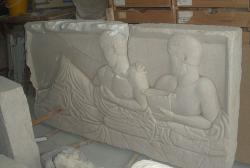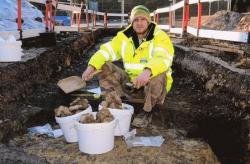18 JANVIER
INDI-UNI : ANTHROPOLOGY - ARCHAEOLOGY
INSCRIPTION 2012 COURS A DISTANCE
REGISTRATION 2012 ONLINE COURSES
GRECE –  Thera - (île de Santorin) : découverte d'un relief d'époque impériale représentant deux hommes .
Thera - (île de Santorin) : découverte d'un relief d'époque impériale représentant deux hommes .
http://www.yppo.gr/2/g22.jsp?obj_id=48934
FRANCE - La Mariniesse - Les fouilles ont mis au jour des vestiges s'étalant sur trois grandes périodes : du premier âge de fer, de la période gallo-romaine et de l'époque médiévale. Du premier âge de fer, des tombes ont été découvertes sous la forme de petites fosses dans lesquelles étaient déposées des urnes dont une servait aux restes de la crémation du défunt et d'autres qui devaient servir de dépotoirs, le tout datant des VIIe et VIe siècles avant notre ère. De l'époque gallo-romaine, les bases d'un bâtiment rectangulaire, sur salins de grès et comptant cinq pièces et une galerie, ont été mises au jour. Les archéologues optent pour les communs d'une exploitation agricole séparés de la villa. Ce sont les silos souterrains avec de grandes fosses piriformes qui ont permis de dater cette bâtisse. De l'époque médiévale (XIIe et XIIIe siècles), ce sont des fragments de céramiques qui ont retrouvés dans le comblement d'un des fossés. De l'époque moderne, les restes de fondations d'un bassin de captation ont été découverts, ainsi qu'un front de taille pour le prélèvement de la grave. Et, encore plus proche de nous, voici une bonne cinquantaine d'années, il y avait un vignoble. S'ils ne sont plus sur le terrain, le travail se poursuit au laboratoire de l'Inrap pour le nettoyage des ossements, des céramiques et l'encollage afin de remettre l'histoire dans on contexte.
http://www.sudouest.fr/2012/01/18/la-mariniesse-et-son-passe-mis-au-jour-608070-4720.php
FRANCE – Escalles - Sur la base des prescriptions de l'État, une équipe d'archéologues du Centre départemental d'archéologie, sous la responsabilité scientifique d'un archéologue de l'INRAP, est intervenue à l'automne 2010 et au printemps 2011 pour fouiller des vestiges datés de 4 000 ans avant J.-C. La fouille du Mont d'Hubert a permis de mettre en évidence un camp de hauteur délimité par un fossé barrant le sommet. Vers 4 000 ans avant notre ère, les sociétés néolithiques à travers l'Europe érigent des systèmes d'enclos fermés par des fossés, des levées de terre et des palissades. Le Mont d'Hubert occupe une position « d'altitude », dominant un vaste secteur dont le Cap Blanc Nez et le détroit du Pas-de-Calais, et offre dans un rayon de 30 km une vue dégagée sur les côtes anglaises et la plaine maritime (Dunkerque, monts de Flandre). La vocation de telles installations reste un sujet de débat : occupation principalement défensive, place centrale d'un vaste territoire constitué de villages, enclos à bestiaux ou lieux de rassemblement cultuels ou funéraires... L'étude du matériel découvert par les archéologues (céramiques, ossements animaux, outils de silex et grès, centaines de litres de coquillages, etc.) permettra d'en apprendre davantage.
http://www.lavoixdunord.fr/Locales/Boulogne_sur_Mer/actualite/Secteur_Boulogne_sur_Mer/2012/01/17/article_des-fouilles-archeologiques-menees-a-esc.shtml
PAKISTAN -  Multan - The eastern wall of the tomb of the great saint Hazrat Shah Ruknuddin Aalam needs urgent attention. There are sections of the wall that are falling apart and in several parts even the tile and mosaic work has been compromised. The tomb of Hazrat Shah Ruknuddin Aalam was built between 1320 and 1324 AD. “This is a pre-Mughal heritage building and it needs to be preserved but the government does not seem to care about its historical significance. I have been visiting the shrine regularly and every time I come here it seems a little more dilapidated. If no one starts refurbishing the boundary wall it could well begin to collapse sooner or later,” said a devotee Mukhtar Ali.
Multan - The eastern wall of the tomb of the great saint Hazrat Shah Ruknuddin Aalam needs urgent attention. There are sections of the wall that are falling apart and in several parts even the tile and mosaic work has been compromised. The tomb of Hazrat Shah Ruknuddin Aalam was built between 1320 and 1324 AD. “This is a pre-Mughal heritage building and it needs to be preserved but the government does not seem to care about its historical significance. I have been visiting the shrine regularly and every time I come here it seems a little more dilapidated. If no one starts refurbishing the boundary wall it could well begin to collapse sooner or later,” said a devotee Mukhtar Ali.
http://tribune.com.pk/story/323049/heritage-slight-shah-ruknuddin-aalam-tomb-in-shambles/
ABOU DHABI – al Dur - The department of archaeology and heritage in Umm Al Qaiwain in the United Arab Emirates (UAE) has announced the discovery of new relics at the al-Dur archaeological site. Some of the items found include a bronze ring, glass beads, a jar containing a glazed-pottery dish, iron arrows and dagger blades. Archaeological excavations that started in 1970 continue till date.
http://www.daijiworld.com/news/news_disp.asp?n_id=127677
ROYAUME UNI –  Crawley - Developers have discovered items dating back to medieval times during an archaeological dig in the town centre. And contractors have found evidence that the site was being lived or worked on between the 11th and 16th centuries. On January 9 work began on digging two trenches inside the car park and another two on the outskirts of the site, which is between High Street and Peglar Way. In two of the trenches, which have been dug to a depth of about half a metre, six square post holes, a drainage ditch and a layer of iron work waste have been found. Iain Williamson, from archaeology company URS which is carrying out the work, said: "During the planning process the site was flagged up as having the potential for having medieval remains. "Crawley was important in the Wealden iron industry during the period when it was the centre of the English iron industry."
Crawley - Developers have discovered items dating back to medieval times during an archaeological dig in the town centre. And contractors have found evidence that the site was being lived or worked on between the 11th and 16th centuries. On January 9 work began on digging two trenches inside the car park and another two on the outskirts of the site, which is between High Street and Peglar Way. In two of the trenches, which have been dug to a depth of about half a metre, six square post holes, a drainage ditch and a layer of iron work waste have been found. Iain Williamson, from archaeology company URS which is carrying out the work, said: "During the planning process the site was flagged up as having the potential for having medieval remains. "Crawley was important in the Wealden iron industry during the period when it was the centre of the English iron industry."
http://www.thisissussex.co.uk/Medieval-history-uncovered-Crawley/story-14456041-detail/story.html
UAE – Sharjah - Sharjah Investment and Development Authority (Shurooq) in collaboration with different Government entities in Sharjah will start its geophysical survey as part of the Heart of Sharjah project, one of the most important heritage projects in the region. The project will be implemented in five phases, and is expected to be completed in 2025. The aim of the first geophysical survey in the Heart of Sharjah area is to apply different survey methods to map and determine the nature and extent of the archaeological record for planning of future development as well as interpretation of any remains of the historic town. It is hoped that the survey will also help us obtain accurate data on the detailed layout old coastal settlement of Sharjah and how it might have changed over the centuries. Another aim is to develop a collaborative long-term training programme with the University of Southampton Department of Archaeology and Marine Archaeology Stewardship Trust (MAST) to look at the potentials to study the origins of traditional coastal settlements in Sharjah and the UAE in general. It is hoped that this survey as well as the longer term project will provide information to assist in the restoration and reconstruction of old buildings in the study areas.
http://www.khaleejtimes.com/DisplayArticle08.asp?xfile=data/theuae/2012/January/theuae_January470.xml§ion=theuae
USA – Maywood - Students who commute from the western suburbs may not know that when they pass the town of Maywood on the regular railroad, they are also passing by the home of a ‘conductor' of the Underground Railroad. As part of DePaul's Urban Historical Archeology Field School, Professor Michael Gregory's fall field experience class began a journey to discover the site of the house of Zebina Eastman. Eastman came to Maywood in the mid 1800's from Vermont. He was a well-known abolitionist and friend of Abraham Lincoln, and served as the Ambassador to England while Lincoln was president.
http://www.depauliaonline.com/news/archeology-students-dig-in-maywood-for-house-of-underground-railroader-1.2743751#.Txb1hm9vsyo
FRANCE – Vire - En novembre, l’Institut national de recherches archéologiques préventives (Inrap) a procédé à un diagnostic, comme le prévoit la loi, à la Mercerie, où la municipalité a entrepris de bâtir un lotissement. Des traces d’habitat datant du Moyen Âge ont été découvertes entraînant un léger contretemps pour le projet immobilier. « Un rapport doit être remis mi-février à l’Etat. La Drac (Direction régionale des affaires culturelles) déterminera ensuite si des fouilles supplémentaires sont nécessaires », ajoute le service communication de l’Inrap.
http://www.ouest-france.fr/actu/actuLocale_-Lotissement-de-la-Mercerie-a-Vire-le-rapport-des-fouilles-archeologiques-remis-mi-fevrier_40771-2033545-pere-region--14366-abd_filDMA.Htm